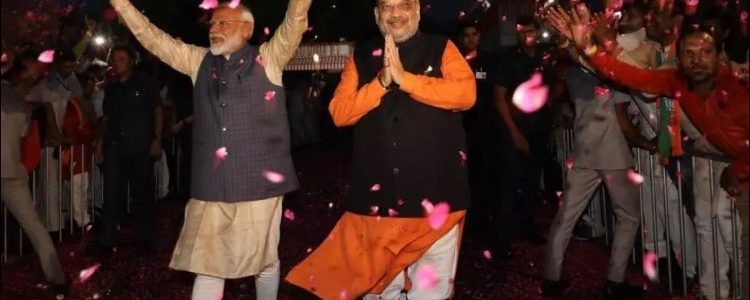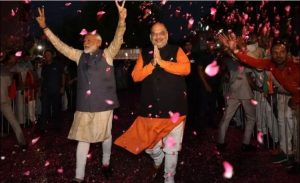
Modi wave storms Indian election

Narendra Modi and his ruling BJP have swept back to power with the party winning 303 seats, with the opposition winning only 52, UPA 33, others 108, in the Lok Sabha, the lower house of India’s parliament, bettering the 282 seats they won in 2014. A arty needed 272 seats for a majority in parliament. Rahul Gandhi’s opposition Indian National Congress (INC) and its allies could not make any meaningful gains.
Nearly half of India’s 900 million registered voters are women. Since independence, female voters in India have increasingly turned out to vote in greater numbers as in 2019, for the first time female voter turnout equaled male voter turnout.
Only 723 of the 8000 candidates were female less than one in ten.
Narendra Modi to take oath as Prime Minister at 7pm, on May 30, 2019.
” Chemistry trumped maths. Happy morning, Friends. We all are familiar with the famous ‘Tryst with Destiny’ speech made by pandit Jawaharlal Nehru on the midnight of 14th August, 1947. But I feel the acceptance speech of Shri Narendramodi which he made to the thousands of BJP workers last night has profound wisdom and statesmanship. Every word Sri Modi spoke speaks volumes of his humble and positive personality and his total dedication to the cause of the nation. Every Indian who wants to learn and grow along the path of excellence can pick up plenty of diamonds of wisdom from his wonderful words. I will here only share a few points that have struck me. Friends, I have analysed his speech not as a Modi fan nor as a person steeped in BJP ideology, but as a student of life. In his entire speech he didn’t mention even once that he won or that he defeated his rivals etc. There was no trace of bitterness in his speech. He said that elections are fought on votes and majority(bahumath) , but nation can march forward” Mr Modi’s victorious speech.”
Former Commissioner of Police, Mumbai, Julio Ribeiro has in a comment said
“In the decade leading up to 1947, undivided India was ravaged by famines and food scarcity. In the 21st century, it is among the top 10 economies of the world. How much of it can be credited to policies and how much to politics?
Speaking in the Parliament in March 2016, PM Modi had said, “If the Congress had helped the poor in 60 years, the poor wouldn’t still be facing trouble…We can’t ignore 60 years of misgovernance.” The constant harping on the 60 years of Congress rule and that the country achieved nothing in that time period could not farther from the truth.
At public rallies before the election in 2014, he would say, “You gave 60 years to the Congress, they gave you nothing but misrule. Give me 60 months to fix the nation’s ills.”
Data collected from several quaters counters this claim and suggests that the PM should not take the masses for granted. “You are the Prime Minister of a country which was under British rule for more than 200 years. The people were living just like slaves. Congress came to power in 1947 after independence started with zero. There was nothing in this country except garbage left behind by the British. India didn’t have the resources then even to produce a pin since the British left India. Electricity was available only in 20 villages across the country. Telephone facilities were available only for 20 rulers (kings) in the country. There was no drinking water supply. There were only 10 small dams. No hospitals, no educational institutions, no fertilisers, no feeds, and no water supply for cultivation. There were no jobs and rampant starvation in the country. There were many infant mortalities. Very few military staff manning our borders. Only 4 planes, 20 tankers & fully open borders on all 4 corners of our country. Very minimum roads and bridges, empty exchequer. Nehru came to power under such circumstances,” he said.
Without taking sides with either party, it would be good to take an objective look at what India achieved in 60 years before Modi came to power.
“In the decade leading up to 1947, undivided India was ravaged by famines and food scarcity. Soon as India became independent, it was confronted with a food and milk crisis. The country had to import 55,000 tonnes of milk powder every year in the early 1950s, according to government records,” a report by Scroll said.
“India was not yet one, its territorial integrity was being challenged, the 1948 war had complicated an already-fraught relationship with Pakistan, new state institutions had to be built, and so on. Through it all, food security could not be compromised. Self-sufficiency was, after all, a key agenda of independent India’s first leaders, and tied deeply to nationalism,” the report said.
In a radio address to the nation in 1952, Prime Minister Jawaharlal Nehru declared that he will raise food production by nearly 8 million tonnes as their goal for the Five Year Plan.
Relying on the economist S Sivasubramonian’s data, Balakrishnan arrayed the growth rate of three key sectors – agriculture, industry and services – to map the trajectory of the Nehruvian economy. He analysed the data for three periods – 1900-’01 to 1946-’47, 1950-’51 to 1964-’65, and 1947-’48 to 1999-2000 – and showed that “not only does growth in the Nehru era amply exceed what was attained in the final half-century of colonial rule but the quickening of the economy observed over the second half of the 20th century may be seen to have been already achieved in the Nehru era,” the report said.
“What has India achieved after 60 years? World’s largest army. Thousands of warplanes, tankers, lakhs of industrial institutions, electricity in almost all villages, hundreds of electric power stations, several kilometres of national highways and over bridges, new railway projects, stadiums, super speciality hospitals, most of the Indian households with television, telephone services for all countrymen. Improved infrastructure to work in and outside the country, Banks, Universities, AIMS, IITS, IIMS, Nuclear weapons, submarines, nuclear stations, ISRO, Navarathna Public sector units,” Ribiero wrote.
“Indian Army split Pakistan into 2 pieces. One lakh military & commanders surrendered to the Indian army. India started exporting minerals & food items. Bank nationalisation by Mrs. Indira Gandhi. Computers were introduced to India and many job opportunities were created in India and outside. India is ranked among the top 10 economies of the world. GSLV, Mangalyan, Monorail, Metro rail, International airports, Prithvi, Agni, Naag, Nuclear submarines….all these were achieved before you became PM,” he said.”
